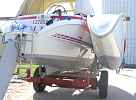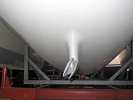Johnt wrote:Is it possible to use a drying mooring with a DF1000?
Does the propeller need to be kept off the bottom at all times or is it recessed above the bottom of the hull?
I am in the market for a DF 1000 and need to specify the mooring type
By "drying mooring" I assume you mean a mooring field anchorage that dries out at low tide, leaving the boat on mud or sand; and not a dock that mechanically lifts and supports the boat on a cradle designed for the boat?
I strongly advise against it. Beaching the boat is great for pictures in marketing literature to illustrate shallow draft capability, but not good for your bottom finish.

The propeller is recessed above the bottom of the hull skeg, but not by a lot, and the skeg provides some protection but is narrow. All Dragonflies built by Quorning have solid fiberglass along the centerline strip of the bottom for about 1-2 feet wide, and the lowest areas are quite sturdy, but most of the hull areas are foam-cored with thin skin to keep the boat light. It can handle a gentle grounding and drying out, and the solid areas will handle it better, but the following cautions apply:
1) It must be a protected area with no wakes or long "fetch". If there are waves and the boat is not "hard aground" (mid-tide?), it could cause repeated pounding against the bottom resulting in eventual damage.
2) Rocks, gravel and shells could cause high point-loads that scratch and damage as the boat moves, could jam in the centerboard slot, or cause damage to bottom skin/core.
3) If the bottom is uneven, or is very soft so the hull sinks deep in mud or sand, or if there is a boulder that protrudes up -- damage to the shaft or prop blades is a possibility.
4) Sand and gravel stuffed into the centerboard, cutlass bearing and shaft tube at start of every use will likely cause premature wear.
5) For ANY boat, your (expensive) anti-fouling paint will not last.
And lastly, you will be restricted by the tides so you won't be able to come and go when you please.

